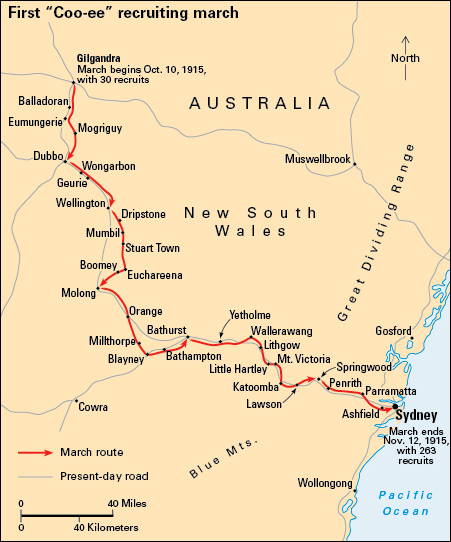Australian recruitment marches of 1915 and 1916 were drives to encourage young men to enlist in the Australian armed forces during World War I (1914-1918). The marches, which typically began in rural communities, gathered recruits along the way to major cities. Upon reaching a city, marchers would volunteer for military service. The marches were sometimes called snowball marches, for the “snowball effect” of rolling up new recruits as they went along. The highly publicized marches helped increase military enlistment and fund-raising for the Australian government.

Background.
In the early 1900’s, Australia was a dominion, or self-governing country, of the British Empire. As a result, when the United Kingdom declared war on Germany on Aug. 4, 1914, Australia was automatically at war.
In Australia at that time, conscription (mandatory enlistment) for overseas service was not allowed, so the military relied on volunteers. More than 52,000 Australians volunteered for military service in 1914. The rate of enlistment peaked in July 1915, but it dropped sharply in the following months. The government soon began efforts to increase the number of people joining the armed forces.
Minimum standards for enlistment—such as age, height, and physical fitness requirements—gradually were eased. Public buildings displayed recruitment posters emphasizing patriotism, social responsibility, and a sense of adventure. Politicians encouraged young men to enlist, and recruiting committees began work in towns throughout the country.
The marches.
In many areas, groups of people agreed to march to the nearest city to enlist in the armed forces. On Oct. 10, 1915, about 30 men left the rural New South Wales town of Gilgandra. Considered the first recruitment march, the Gilgandra group departed on foot for Sydney, roughly 320 miles (515 kilometers) away. In towns along the route, the men shouted “coo-ee”—a common call of the Australian outback—to attract attention. The marchers encouraged others to join them and to “do their part” for Australia, the king, and the British Empire. In Sydney, thousands of people turned out to welcome the tired and dirty “Coo-ees,” who reached the city with 263 recruits on November 12.

Several other recruitment marches soon sprang up around the country. The marchers took on such names as the Men from Snowy River, the Kurrajongs, the Kookaburras, and the Boomerangs. Drums, bagpipes, and marching bands sometimes accompanied the marches, which often took on the character of holiday parades.
The marches brought in more than 1,500 new recruits for Australia’s military. In addition, the publicity surrounding the marches encouraged other men to enlist. The marches also helped fund-raising efforts for the war. The majority of the recruitment marches took place in 1915 and 1916, though some were organized in the last year of the war.
Aftermath.
In all, more than 416,000 Australians enlisted for military service during World War I. More than 330,000 saw service overseas, mostly in the bloody campaigns of the Middle East, France, and Belgium. About 60,000 were killed, and another 156,000 were wounded or captured. More than 2,000 Australian women served overseas in the Australian Army Nursing Service.
